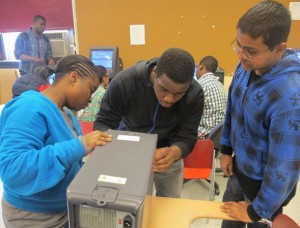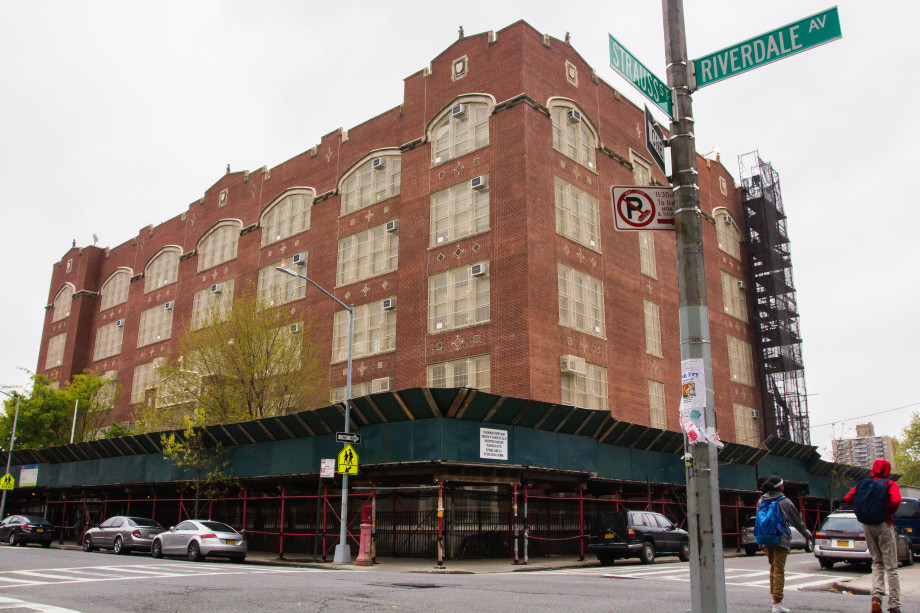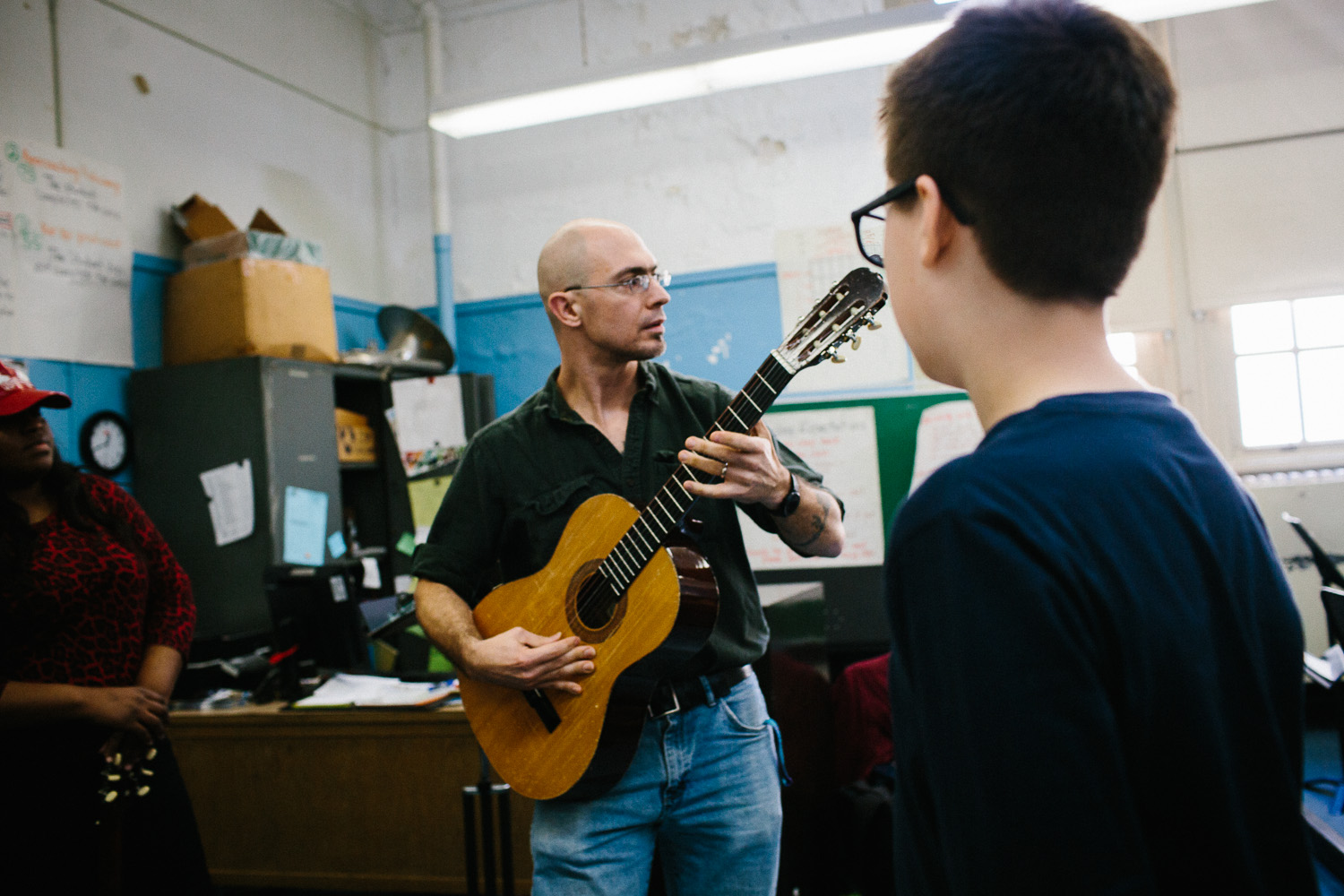A small team of students in a Crown Heights, Brooklyn, classroom set out to solve the mystery. Was it a faulty power chord? Perhaps the system needed drivers installed? Somehow, the computers clustered around the room had stopped working. But the students were not about to let them stay broken. They were determined to find out the problem—and hopefully the solution.
“Let’s get those three computers on and find out what the situation is,” said technology teacher Chris Leung. The students booted up black computers placed on tables around the large, well-lit room. There were signs of earlier sleuthing. One computer was labeled “Defective.” Another one read “Done” with the names of students written on the sheet.

While some afterschool activities focus on athletics or arts, these students in the computer club at Pathways in Technology school use the same team-building spirit to fix computers and learn problem-solving skills together. Leung, who teaches computer programming at the new public school in Brooklyn where students can pursue an associate’s degree after earning their high school diploma, said he is trying to impart computer skills and encourage students’ enthusiasm for the field. “I hope to develop their interest in IT,” said Leung, who worked in information technology as a systems administrator before becoming a teacher. As the students work on computers, Leung walks around the room and coaches the students, who act as a team.
One student, Gabriel Rosa, 14, said the club, which meets on Thursday afternoons, teaches everything “down to the basics of how a computer functions.” “It’s different than the other clubs,” he said. “You get more hands-on with the equipment.”
The students practice their skills on non-working computers that are no longer being used by Paul Robeson High School, which is in the same building as Pathways. The computers, mostly Dell desktops with black, square monitors, may have glitches ranging from a slow operating system to difficulty connecting to the Internet.
Some of the problems are simple; others require real effort to solve.
One team of two was trying to connect to the Internet. “You have to go to settings,” one of the pair said. The students then clicked through tabs under the computer’s settings menu to try to solve the problem.
Another computer presented a particularly odd-looking ailment: the display screen was warping inward rather than filling the rectangular screen. A student came over to work with the students wrestling with the problem. Clicking through the settings on the computer, the students were able to restore the computer to a normal blue screensaver with goldfish swimming about.
Leung walked around observing the students and instructed them if they got stuck. When one computer functioned smoothly, and another didn’t, Leung offered a problem-solving strategy: “Compare it to what’s on this computer.” The students typed in the new proxy setting and the Internet began to work on the second computer.
“These computers came from nothing to something,” said David Samuel, 14, in amazement. Samuel, who wants to become a software engineer, said knowing how to fix computer glitches, such as shutdowns and memory problems, will make it easier when he tackles more advanced problems.
The students said that solving a problem in the computer club gave them a sense of accomplishment. “Sometimes it takes a long time, and when you finally get it working, it feels like you accomplished something,” said Rahat Mahmud, 14. He said he has a “very big interest in computers” and his favorite part of the club is opening the machines and fixing them.
Another student, Monesia McKnight, 14, agreed. “It makes me feel like I’ve won a million dollars every time,” she said.
McKnight hopes the club will help her when she is pursuing her associate’s degree in computer engineering. “I’ll already have an insight on what to do when other kids are just waiting for the teacher to teach,” she said. McKnight said the club allows her to relax and learn at her own pace. In the club’s 10 sessions, McKnight said she has learned how to update the computers, use Linux, understand the difference between the CD and DVD drives, and master command shortcuts on the keyboard.
McKnight is currently the only girl in the club. “It’s like living with a bunch of older brothers,” she explained. She said the students learn both from the teacher and from each other. “People learn better when they’re around people their own age,” she said.
And what will become of the computers now running smoothly? “We haven’t planned that far yet,” said McKnight, laughing. She explained that as soon as one computer is fixed, they move on to try to make others run faster.
At the end of the club, three computers were working and two more were in the process of being fixed. The students were more relaxed and laughed as they made an old iMac say in a robotic voice: “My favorite food is pizza.”
Leung said the club enables students to explore computers without worrying about wrecking something as they might when using their own computers. “If you break it, then you get a chance to open it up,” he explained. The students can ask a teacher and each other any questions, and then pass on information to other students, said Leung.
The club allows extra learning time beyond classroom periods. “We can try different things we don’t always get a chance to do in the classroom,” Leung said. And while Leung said right now the club is mainly for fun, he said there is no reason the club could not develop to become more educational or even to allow the students to begin repairing the laptops they use everyday in classrooms.
And as student, Gabriel Rosa, said: “We all cooperate well.”



